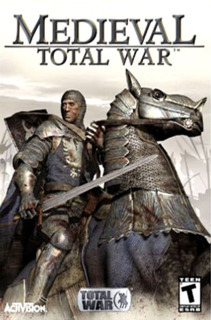Relive history's greatest battles
Then when your armies meet an opposing army, the game switches to the real time battlefield fighting, and here is where the game gets even more interesting. Unlike most strategy war games, where you often have to drag boxes around the units and tell them to attack, Medieval wages war by grouping the armies into squads of the same unit type. No longer do you have to micromanage tiny units. You just control the different squads. The game features a dynamic battle system where you can assign the basic formation type and how deep the ranks go, but with your mouse you can modify the formation by "painting" where it goes, how wide it is, and at what angle it will engage the enemy. The different units work best against different enemy types. Rows of archers and longbowmen can scatter your foes and weaken their ranks while they head towards your army. However your archers need protection from close range encounters. Pikemen are best when they're planted firmly in place and wait for charging knights. Swordsmen are your basic units, and knights can work wonders even in small squads. And don't underestimate your peasants. Victory is determined by a number of factors. The relative strength of your generals is a plus. But placement, timing, and facing the right direction, as well as having the right troops, are the biggest factors. Your king can also join the battle as a slightly beefed up knight, but take care that he doesn't die in battle. The game, thankfully, features tutorials that give you the basics in proven medieval tactics. One favored tactic is to hide two different squads in forests on the opposite sides of a valley that the enemy is coming up. Another squad stands in plain sight in the middle of the valley to meet the enemy while the two hiding squads wait until the enemy is past them before springing a charge. The game is also realistic in that if one of your squads is starting to lose badly, the units in that squad will start to run away, and you will lose complete control of them until they get their bravery back.
If you have won the battle, any enemy units that have fled will escape to a friendly county if one exists. Any people you captured during the battle can have their fated decided upon by you, whether it's to let them go, execute them, or execute only the leaders. If the enemy escapes into a nearby castle, you can go into siege mode, where you wear down their resources until you decide to attack them, and here is where the very cool siege engines like catapults, trebuchets, and ballistas come into play. Of course if you have lost the battle, all of the above can happen to you.
Medieval is a very deep, thoroughly enjoyable game, but several things keep it down from the best. For one, the graphics, while servicable, are nowhere near the level seen in Rome. Second, campaigns take a long time to complete. Finally, I find it annoying that even if I'm allies with a nation, the leader still won't let me march through his country down what is often the only path to my goal unless it's part of a crusade. Even still, these minor nitpicks don't destroy what is otherwise a solid strategy game.

